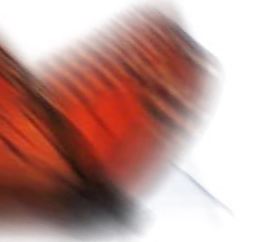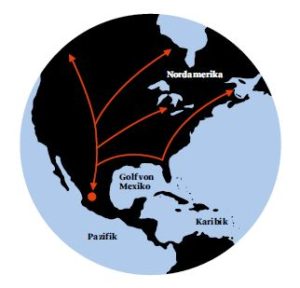Monarch butterflies flutter to Canada and 4,000 km back
 Southward bound
Southward bound
The monarch butterfly, whose magnificent wings are featured on the cover of this issue, weighs less than a gram. That does not stop it from flying up to 4,000 kilometres across North America to reach its winter habitat in Mexico. In the spring several hundred million individuals then make their way back. On the way, around the beginning of April, the females lay their first eggs along the Rio Grande before dying shortly thereafter. The first of three generations of monarchs develops from those eggs. Each generation lives for about two months as they continue their trek northwards to reach their summer habitat between the Great Lakes and Newfoundland. In September, it is the fourth generation, the Methuselah generation as it is called, that lives for up to eight months and makes the journey back. How the monarchs are able to orient themselves along the way has largely been explained by science: the butterflies are able to navigate using the position of the sun and their internal clock to differentiate between north and south. It even works when it is cloudy, as their compound eyes can still perceive the polarised light of the sun as a ring-shaped halo on the horizon. In addition, they can presumably orient themselves using the Earth’s magnetic field. An unsolved mystery remains as to how the insects make their way northwards and back to their winter habitat, which is just several hectares in size, although those particular individuals have never been there before. Presumably the target information is somehow passed on from generation to generation across all stages of development (egg-caterpillar-pupa-butterfly). And even if science has yet to deliver an answer: that will not stop the butterfies from finding their way.
Big commitment to little living creatures
 Though hundreds of millions of monarch butterflies migrate each year, the species faces many threats. The decline in insects is a global issue – Ratingen, where Mitsubishi Electric is based, is no exception. Knowing that small changes can make a big difference for bees, butterflies and other insects, the landscaping at Mitsubishi Electric headquarters has recently been transformed into an inviting habitat for plants, insects, birds and reptiles right here in Ratingen, Germany.
Though hundreds of millions of monarch butterflies migrate each year, the species faces many threats. The decline in insects is a global issue – Ratingen, where Mitsubishi Electric is based, is no exception. Knowing that small changes can make a big difference for bees, butterflies and other insects, the landscaping at Mitsubishi Electric headquarters has recently been transformed into an inviting habitat for plants, insects, birds and reptiles right here in Ratingen, Germany.
The NaturRaum project, a mix of flowering perennials and scattered fruit trees, has been created in collaboration with the Nature and Biodiversity Conservation Union Germany. A long dry wall provides ample habitat for lizards and other warmth-loving animals, which can take shelter in all the nooks and crannies between the stones. A small brook meanders through the landscaping, providing refuge for other insects and animals.
In total, 12 fruit trees, 4 multi-variety fruit trees, 6 berry bushes, 6 lavender hedges, 18 different herbs and 2,115 flowering perennials were planted. The space has been transformed into an oasis for flora and fauna, which we hope will continue to grow and flourish.
You will find more information at: www.nabu.de and www.deutschland-summt.de
Changes No. 7
Please click on the picture to open the Changes No. 7.
Download
Download the latest Changes as PDF.
Subscribe
Subscribe for the print edition of our customer magazine “Changes”.

 Southward bound
Southward bound

